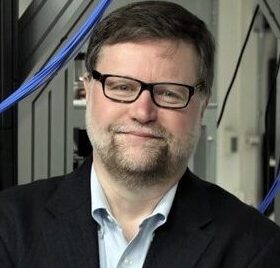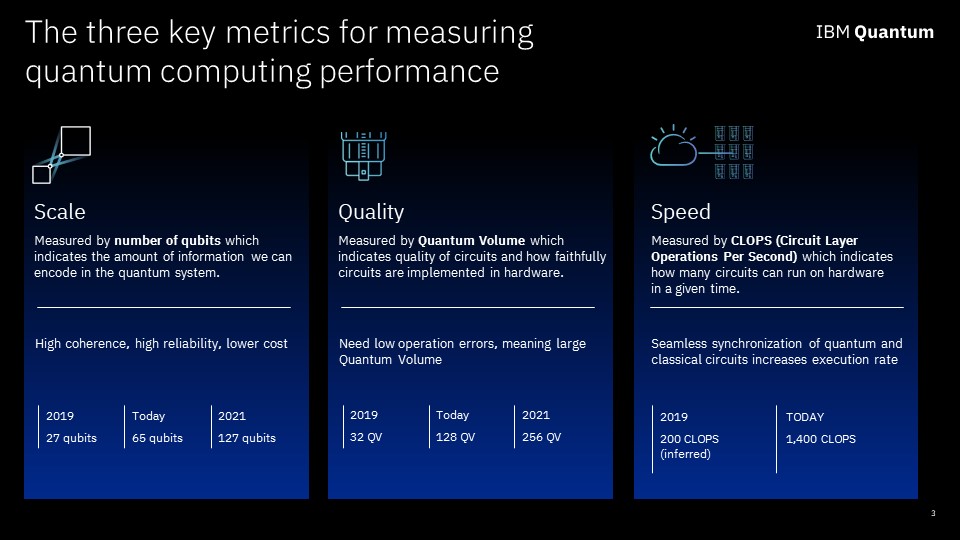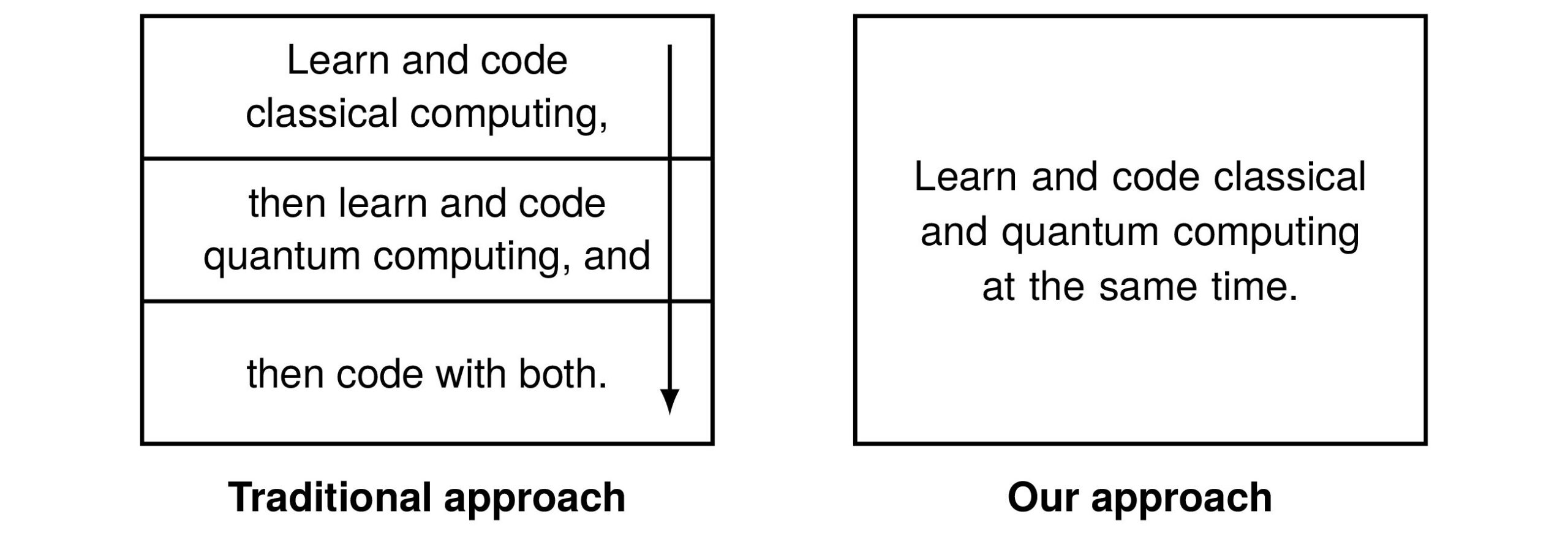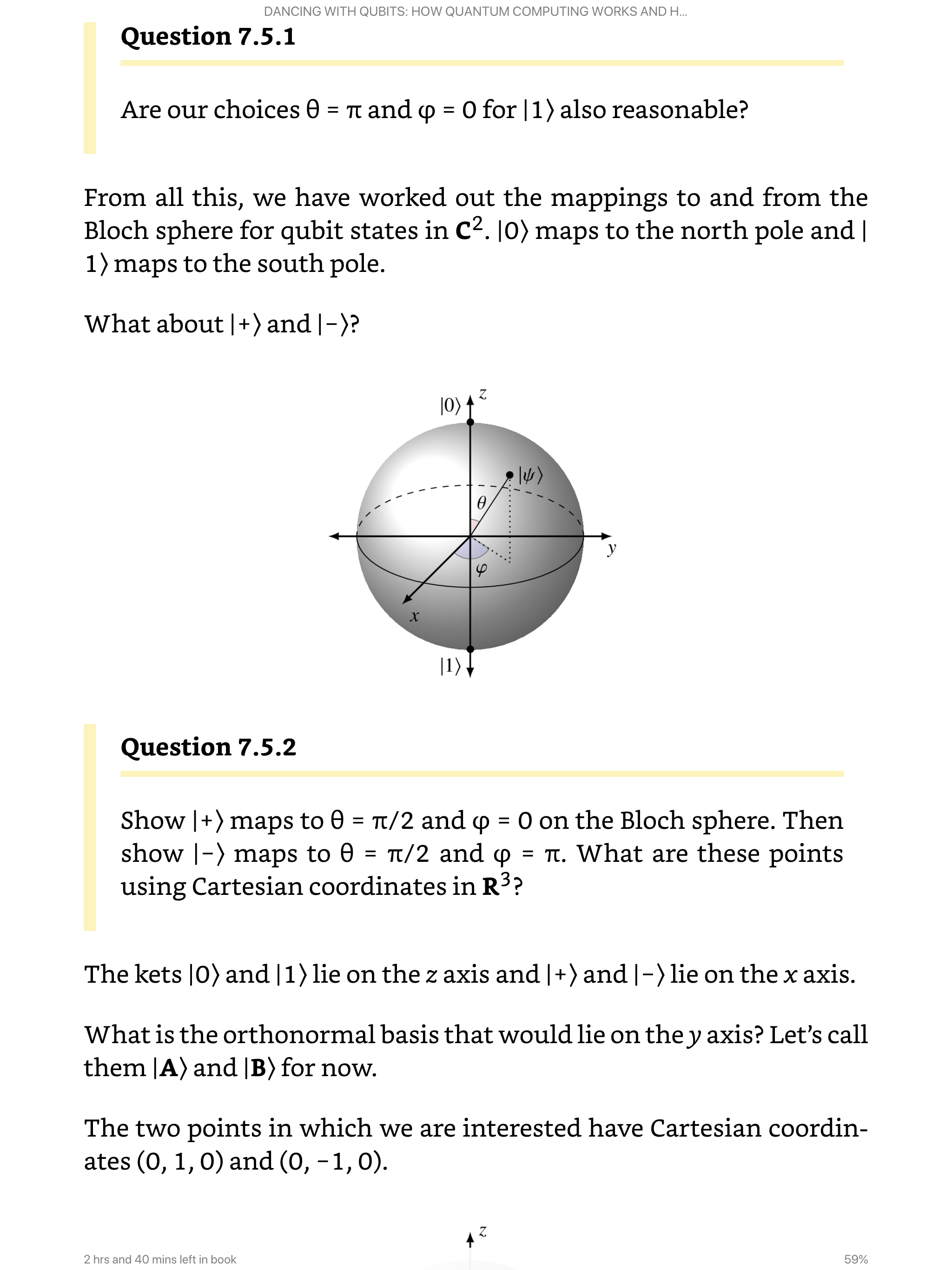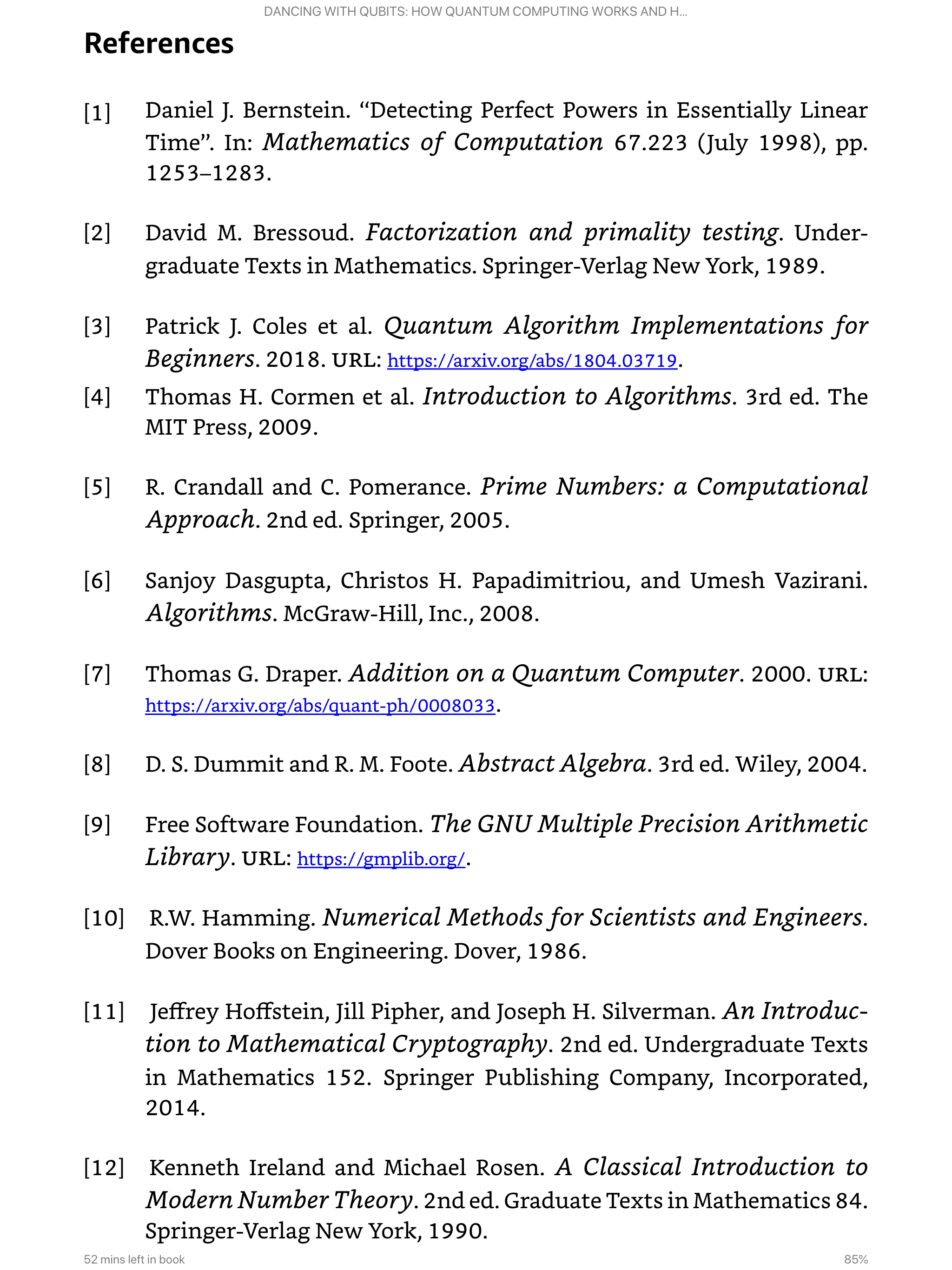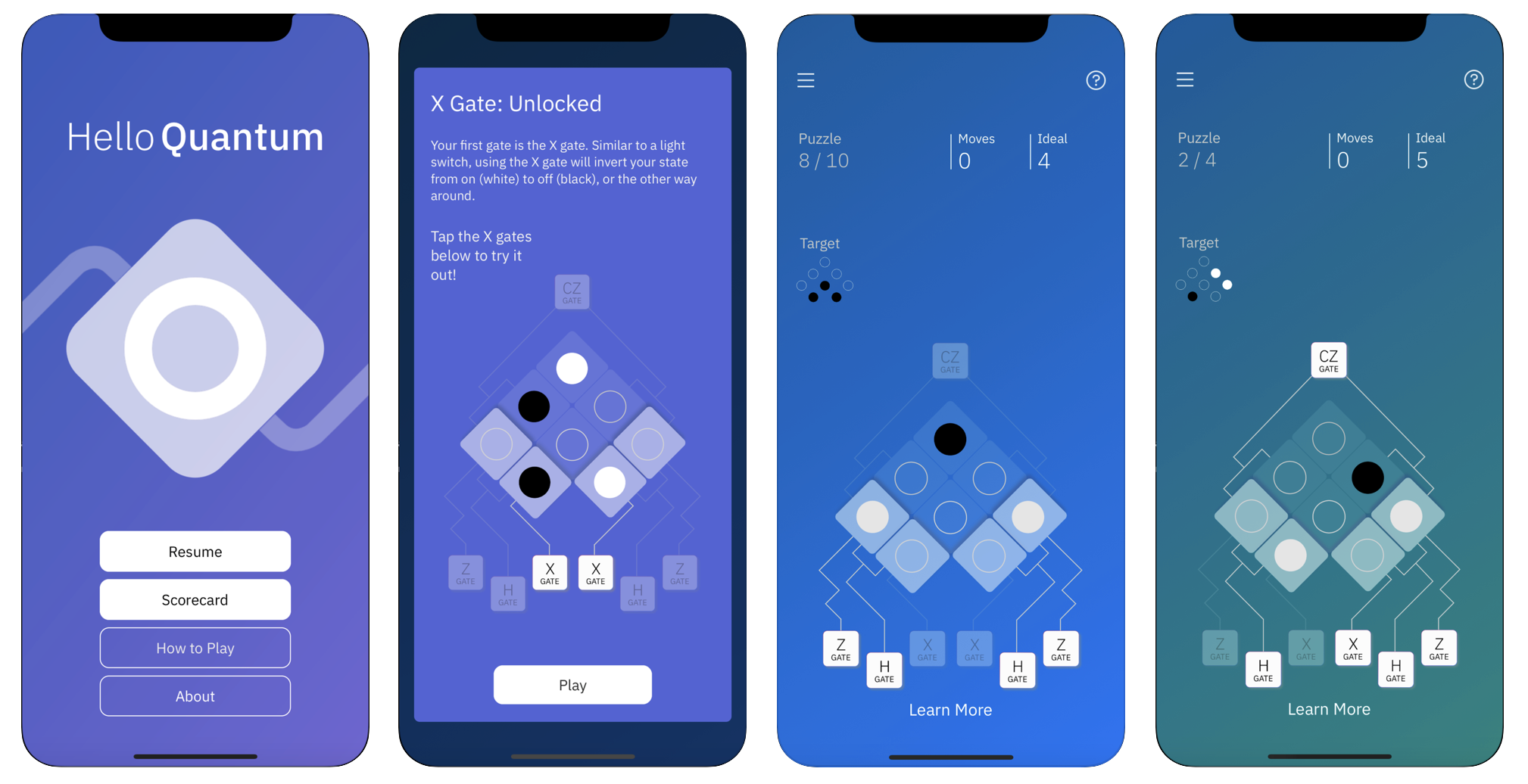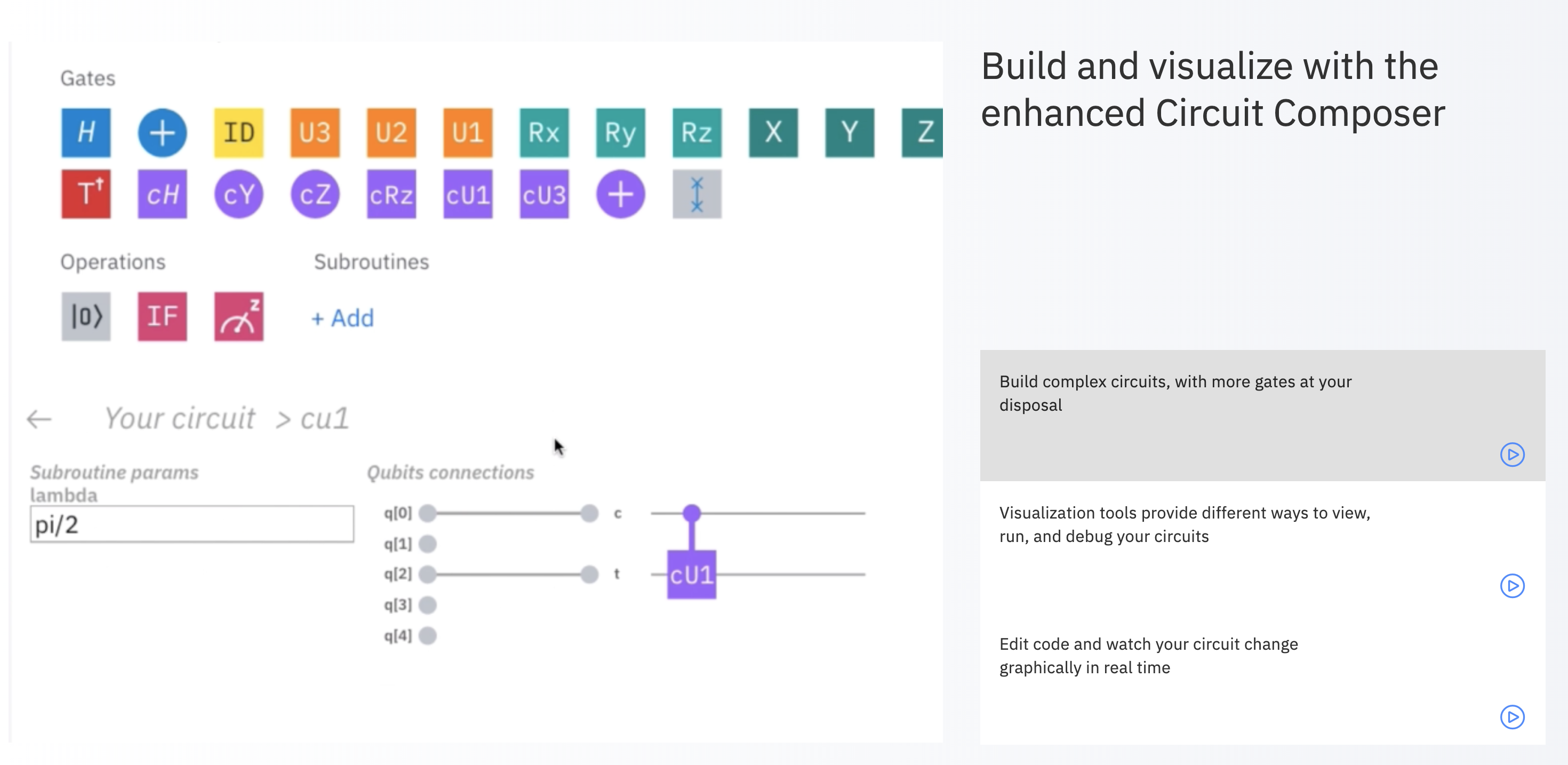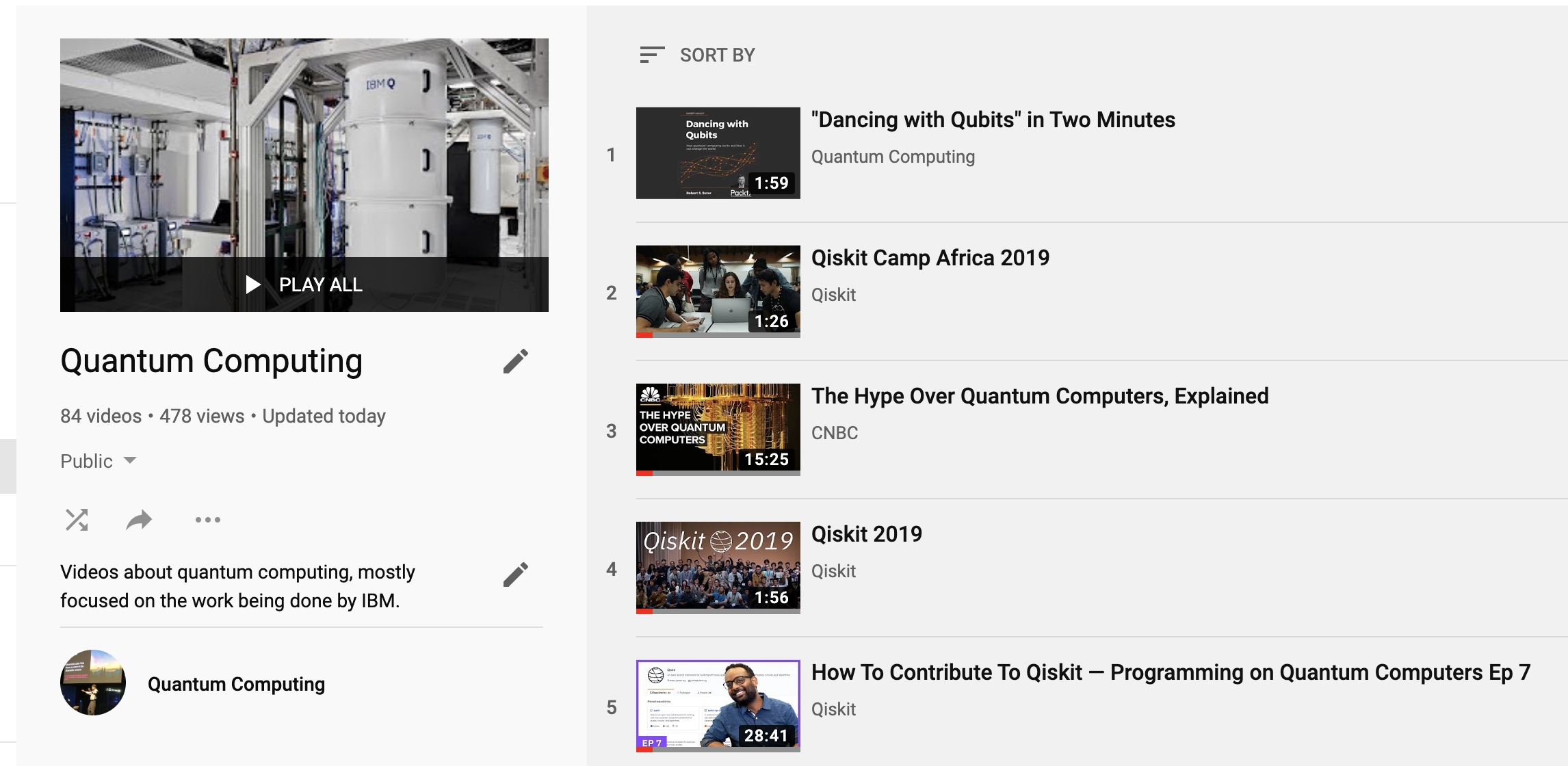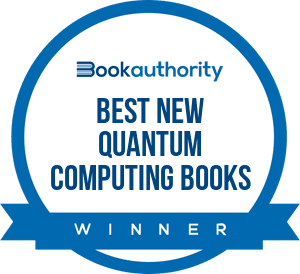A selection of the most important recent news, articles, and papers about quantum computing.
News, Articles, and Analyses
The Long-Term Forecast for Quantum Computing Still Looks Bright – Boston Consulting Group
Authors: Jean-François Bobier; Matt Langione; Cassia Naudet-Baulieu; Zheng Cui; and Eitoku Watanabe
“Is quantum computing finally nearing the point where it can fulfill its transformative potential? The answer, right now, is mixed.”
Quantum June 2024 Monthly Market Snapshot Report – The Futurum Group
Author: Dr. Bob Sutor
“Learn about market & tech developments in the quantum computing industry in June 2024, including improved qubits and product sales & delivery.”
Technical Papers and Preprints
Physics – Mechanical Coupling to Spin Qubits
(Wednesday, June 26, 2024) “A vibrating nanobeam could be used to share information between distant solid-state spin qubits, potentially allowing use of these qubits in complex computations.”
Physics – Measuring Qubits with “Time Travel” Protocol
(Thursday, June 27, 2024) “Quantum sensing can benefit from entanglement protocols that can be interpreted as allowing qubits to go backward in time to choose an optimal initial state.”
[2407.13012] CUAOA: A Novel CUDA-Accelerated Simulation Framework for the QAOA
Authors: Stein, Jonas; Blenninger, Jonas; Bucher, David; Eder, Josef Peter; Çetiner, Elif; Zorn, Maximilian; Linnhoff-Popien, Claudia
 (Wednesday, July 17, 2024) “The Quantum Approximate Optimization Algorithm (QAOA) is a prominent quantum algorithm designed to find approximate solutions to combinatorial optimization problems, which are challenging for classical computers. In the current era, where quantum hardware is constrained by noise and limited qubit availability, simulating the QAOA remains essential for research. However, existing state-of-the-art simulation frameworks suffer from long execution times or lack comprehensive functionality, usability, and versatility, often requiring users to implement essential features themselves. Additionally, these frameworks are primarily restricted to Python, limiting their use in safer and faster languages like Rust, which offer, e.g., advanced parallelization capabilities. In this paper, we develop a GPU accelerated QAOA simulation framework utilizing the NVIDIA CUDA toolkit. This framework offers a complete interface for QAOA simulations, enabling the calculation of (exact) expectation values, direct access to the statevector, fast sampling, and high-performance optimization methods using an advanced state-of-the-art gradient calculation technique. The framework is designed for use in Python and Rust, providing flexibility for integration into a wide range of applications, including those requiring fast algorithm implementations leveraging QAOA at its core. The new framework’s performance is rigorously benchmarked on the MaxCut problem and compared against the current state-of-the-art general-purpose quantum circuit simulation frameworks Qiskit and Pennylane as well as the specialized QAOA simulation tool QOKit. Our evaluation shows that our approach outperforms the existing state-of-the-art solutions in terms of runtime up to multiple orders of magnitude. Our implementation is publicly available at https://github.com/JFLXB/cuaoa and Zenodo.”
(Wednesday, July 17, 2024) “The Quantum Approximate Optimization Algorithm (QAOA) is a prominent quantum algorithm designed to find approximate solutions to combinatorial optimization problems, which are challenging for classical computers. In the current era, where quantum hardware is constrained by noise and limited qubit availability, simulating the QAOA remains essential for research. However, existing state-of-the-art simulation frameworks suffer from long execution times or lack comprehensive functionality, usability, and versatility, often requiring users to implement essential features themselves. Additionally, these frameworks are primarily restricted to Python, limiting their use in safer and faster languages like Rust, which offer, e.g., advanced parallelization capabilities. In this paper, we develop a GPU accelerated QAOA simulation framework utilizing the NVIDIA CUDA toolkit. This framework offers a complete interface for QAOA simulations, enabling the calculation of (exact) expectation values, direct access to the statevector, fast sampling, and high-performance optimization methods using an advanced state-of-the-art gradient calculation technique. The framework is designed for use in Python and Rust, providing flexibility for integration into a wide range of applications, including those requiring fast algorithm implementations leveraging QAOA at its core. The new framework’s performance is rigorously benchmarked on the MaxCut problem and compared against the current state-of-the-art general-purpose quantum circuit simulation frameworks Qiskit and Pennylane as well as the specialized QAOA simulation tool QOKit. Our evaluation shows that our approach outperforms the existing state-of-the-art solutions in terms of runtime up to multiple orders of magnitude. Our implementation is publicly available at https://github.com/JFLXB/cuaoa and Zenodo.”
[2407.13616] Quantum Local Search for Traveling Salesman Problem with Path-Slicing Strategy
Authors: Liu, Chen-Yu; Matsuyama, Hiromichi; Huang, Wei-hao; Yamashiro, Yu
 (Thursday, July 18, 2024) “We present novel path-slicing strategies integrated with quantum local search to optimize solutions for the Traveling Salesman Problem (TSP), addressing the limitations of current Noisy Intermediate-Scale Quantum (NISQ) technologies. Our hybrid quantum-classical approach leverages classical path initialization and quantum optimization to effectively manage the computational challenges posed by the TSP. We explore various path slicing methods, including k-means and anti-k-means clustering, to divide the TSP into manageable subproblems. These are then solved using quantum or classical solvers. Our analysis, performed on multiple TSP instances from the TSPlib, demonstrates the ability of our strategies to achieve near-optimal solutions efficiently, highlighting significant improvements in solving efficiency and resource utilization. This approach paves the way for future applications in larger combinatorial optimization scenarios, advancing the field of quantum optimization.”
(Thursday, July 18, 2024) “We present novel path-slicing strategies integrated with quantum local search to optimize solutions for the Traveling Salesman Problem (TSP), addressing the limitations of current Noisy Intermediate-Scale Quantum (NISQ) technologies. Our hybrid quantum-classical approach leverages classical path initialization and quantum optimization to effectively manage the computational challenges posed by the TSP. We explore various path slicing methods, including k-means and anti-k-means clustering, to divide the TSP into manageable subproblems. These are then solved using quantum or classical solvers. Our analysis, performed on multiple TSP instances from the TSPlib, demonstrates the ability of our strategies to achieve near-optimal solutions efficiently, highlighting significant improvements in solving efficiency and resource utilization. This approach paves the way for future applications in larger combinatorial optimization scenarios, advancing the field of quantum optimization.”
Share this:
Notable and Interesting Recent Quantum News, Articles, and Papers for Wednesday, July 17, 2024
A selection of the most important recent news, articles, and papers about quantum computing.
News, Articles, and Analyses
Infleqtion Leads the Way with First Quantum Computer Installation at NQCC — Infleqtion
(Tuesday, July 16, 2024) “We’re thrilled to announce the installation of our state-of-the-art neutral atom quantum computer at the National Quantum Computing Centre (NQCC). As the first company to deploy hardware under the NQCC’s quantum computing testbed programme, this milestone showcases our cutting-edge technology and de”
Oxford company unveils ‘pivotal’ quantum computing chip – BBC News
(Tuesday, July 16, 2024) “Oxford Ionics claim to have created the first quantum chip of its kind that could be mass-produced.”
Pritzker announces federal partner for quantum computing campus
(Wednesday, July 17, 2024) “CHICAGO (WCIA) — Illinois’ proposal to create a new quantum computing campus has a new partner with a federal agency. Governor J.B. Pritzker announced the partnership of Defense Advanced Research Projects Agency, part of the U.S. Department of Defense, with Illinois’ quantum computing campus Tuesday. The partnership is named Quantum Proving Ground. “The future of […]”
Technical Papers and Preprints
[2107.02151] Continuous Variable Quantum Algorithms: an Introduction
Authors: Buck, Samantha; Coleman, Robin; Sargsyan, Hayk
 (Monday, July 05, 2021) “Quantum computing is usually associated with discrete quantum states and physical quantities possessing discrete eigenvalue spectrum. However, quantum computing in general is any computation accomplished by the exploitation of quantum properties of physical quantities, discrete or otherwise. It has been shown that physical quantities with continuous eigenvalue spectrum can be used for quantum computing as well. Currently, continuous variable quantum computing is a rapidly developing field both theoretically and experimentally. In this pedagogical introduction we present the basic theoretical concepts behind it and the tools for algorithm development. The paper targets readers with discrete quantum computing background, who are new to continuous variable quantum computing.”
(Monday, July 05, 2021) “Quantum computing is usually associated with discrete quantum states and physical quantities possessing discrete eigenvalue spectrum. However, quantum computing in general is any computation accomplished by the exploitation of quantum properties of physical quantities, discrete or otherwise. It has been shown that physical quantities with continuous eigenvalue spectrum can be used for quantum computing as well. Currently, continuous variable quantum computing is a rapidly developing field both theoretically and experimentally. In this pedagogical introduction we present the basic theoretical concepts behind it and the tools for algorithm development. The paper targets readers with discrete quantum computing background, who are new to continuous variable quantum computing.”
Towards quantum enhanced adversarial robustness in machine learning | Nature Machine Intelligence
(Thursday, May 25, 2023) “To fulfil the potential of quantum machine learning for practical applications in the near future, it needs to be robust against adversarial attacks. West and colleagues give an overview of recent developments in quantum adversarial machine learning, and outline key challenges and future research directions to advance the field.”
[2407.02467] Error mitigation with stabilized noise in superconducting quantum processors
Authors: Kim, Youngseok; Govia, Luke C. G.; Dane, Andrew; Berg, Ewout van den; Zajac, David M.; Mitchell, Bradley; Liu, Yinyu; Balakrishnan, Karthik; Keefe, George; Stabile, Adam; Pritchett, Emily; Stehlik, Jiri; Kandala, Abhinav
 (Tuesday, July 02, 2024) “Pre-fault tolerant quantum computers have already demonstrated the ability to estimate observable values accurately, at a scale beyond brute-force classical computation. This has been enabled by error mitigation techniques that often rely on a representative model on the device noise. However, learning and maintaining these models is complicated by fluctuations in the noise over unpredictable time scales, for instance, arising from resonant interactions between superconducting qubits and defect two-level systems (TLS). Such interactions affect the stability and uniformity of device performance as a whole, but also affect the noise model accuracy, leading to incorrect observable estimation. Here, we experimentally demonstrate that tuning of the qubit-TLS interactions helps reduce noise instabilities and consequently enables more reliable error-mitigation performance. These experiments provide a controlled platform for studying the performance of error mitigation in the presence of quasi-static noise. We anticipate that the capabilities introduced here will be crucial for the exploration of quantum applications on solid-state processors at non-trivial scales.”
(Tuesday, July 02, 2024) “Pre-fault tolerant quantum computers have already demonstrated the ability to estimate observable values accurately, at a scale beyond brute-force classical computation. This has been enabled by error mitigation techniques that often rely on a representative model on the device noise. However, learning and maintaining these models is complicated by fluctuations in the noise over unpredictable time scales, for instance, arising from resonant interactions between superconducting qubits and defect two-level systems (TLS). Such interactions affect the stability and uniformity of device performance as a whole, but also affect the noise model accuracy, leading to incorrect observable estimation. Here, we experimentally demonstrate that tuning of the qubit-TLS interactions helps reduce noise instabilities and consequently enables more reliable error-mitigation performance. These experiments provide a controlled platform for studying the performance of error mitigation in the presence of quasi-static noise. We anticipate that the capabilities introduced here will be crucial for the exploration of quantum applications on solid-state processors at non-trivial scales.”
[2407.05178] A typology of quantum algorithms
Authors: Arnault, Pablo; Arrighi, Pablo; Herbert, Steven; Kasnetsi, Evi; Li, Tianyi
 (Saturday, July 06, 2024) “We draw the current landscape of quantum algorithms, by classifying about 130 quantum algorithms, according to the fundamental mathematical problems they solve, their real-world applications, the main subroutines they employ, and several other relevant criteria. The primary objectives include revealing trends of algorithms, identifying promising fields for implementations in the NISQ era, and identifying the key algorithmic primitives that power quantum advantage.”
(Saturday, July 06, 2024) “We draw the current landscape of quantum algorithms, by classifying about 130 quantum algorithms, according to the fundamental mathematical problems they solve, their real-world applications, the main subroutines they employ, and several other relevant criteria. The primary objectives include revealing trends of algorithms, identifying promising fields for implementations in the NISQ era, and identifying the key algorithmic primitives that power quantum advantage.”
Share this:
Notable and Interesting Recent Quantum News, Articles, and Papers for Saturday, July 13, 2024
A selection of the most important recent news, articles, and papers about quantum computing.
News and Articles
A breakthrough on the edge: One step closer to topological quantum computing
(Wednesday, July 10, 2024) “Researchers at the University of Cologne have achieved a significant breakthrough in quantum materials, potentially setting the stage for advancements in topological superconductivity and robust quantum computing / publication in ‘Nature Physics’”
Partnership boosts UK access to most powerful quantum technologies – UKRI
(Thursday, July 11, 2024) “UK industry and researchers will gain unparalleled access to the world’s most powerful quantum computers.”
Bob Sutor; Vice President and Practice Lead, Emerging Technologies, The Futurum Group will speak at IQT Quantum + AI in New York City October 29-30 – Inside Quantum Technology
(Friday, July 12, 2024) “Bob Sutor; Vice President and Practice Lead, Emerging Technologies, The Futurum Group will speak at IQT Quantum + AI in New York City October 29-30. Dr. Bob Sutor has been a technical leader and executive in the IT industry for over 40 years. He is a theoretical mathematician by training, with a Ph.D. from Princeton”
Technical Papers and Preprints
[2406.17653] Algorithmic Fault Tolerance for Fast Quantum Computing
 (Tuesday, June 25, 2024) “Fast, reliable logical operations are essential for the realization of useful quantum computers, as they are required to implement practical quantum algorithms at large scale. By redundantly encoding logical qubits into many physical qubits and using syndrome measurements to detect and subsequently correct errors, one can achieve very low logical error rates. However, for most practical quantum error correcting (QEC) codes such as the surface code, it is generally believed that due to syndrome extraction errors, multiple extraction rounds — on the order of the code distance d — are required for fault-tolerant computation. Here, we show that contrary to this common belief, fault-tolerant logical operations can be performed with constant time overhead for a broad class of QEC codes, including the surface code with magic state inputs and feed-forward operations, to achieve “algorithmic fault tolerance”. Through the combination of transversal operations and novel strategies for correlated decoding, despite only having access to partial syndrome information, we prove that the deviation from the ideal measurement result distribution can be made exponentially small in the code distance. We supplement this proof with circuit-level simulations in a range of relevant settings, demonstrating the fault tolerance and competitive performance of our approach. Our work sheds new light on the theory of fault tolerance, potentially reducing the space-time cost of practical fault-tolerant quantum computation by orders of magnitude.”
(Tuesday, June 25, 2024) “Fast, reliable logical operations are essential for the realization of useful quantum computers, as they are required to implement practical quantum algorithms at large scale. By redundantly encoding logical qubits into many physical qubits and using syndrome measurements to detect and subsequently correct errors, one can achieve very low logical error rates. However, for most practical quantum error correcting (QEC) codes such as the surface code, it is generally believed that due to syndrome extraction errors, multiple extraction rounds — on the order of the code distance d — are required for fault-tolerant computation. Here, we show that contrary to this common belief, fault-tolerant logical operations can be performed with constant time overhead for a broad class of QEC codes, including the surface code with magic state inputs and feed-forward operations, to achieve “algorithmic fault tolerance”. Through the combination of transversal operations and novel strategies for correlated decoding, despite only having access to partial syndrome information, we prove that the deviation from the ideal measurement result distribution can be made exponentially small in the code distance. We supplement this proof with circuit-level simulations in a range of relevant settings, demonstrating the fault tolerance and competitive performance of our approach. Our work sheds new light on the theory of fault tolerance, potentially reducing the space-time cost of practical fault-tolerant quantum computation by orders of magnitude.”
[2407.02553] Large-scale quantum reservoir learning with an analog quantum computer
 (Tuesday, July 02, 2024) “Quantum machine learning has gained considerable attention as quantum technology advances, presenting a promising approach for efficiently learning complex data patterns. Despite this promise, most contemporary quantum methods require significant resources for variational parameter optimization and face issues with vanishing gradients, leading to experiments that are either limited in scale or lack potential for quantum advantage. To address this, we develop a general-purpose, gradient-free, and scalable quantum reservoir learning algorithm that harnesses the quantum dynamics of neutral-atom analog quantum computers to process data. We experimentally implement the algorithm, achieving competitive performance across various categories of machine learning tasks, including binary and multi-class classification, as well as timeseries prediction. Effective and improving learning is observed with increasing system sizes of up to 108 qubits, demonstrating the largest quantum machine learning experiment to date. We further observe comparative quantum kernel advantage in learning tasks by constructing synthetic datasets based on the geometric differences between generated quantum and classical data kernels. Our findings demonstrate the potential of utilizing classically intractable quantum correlations for effective machine learning. We expect these results to stimulate further extensions to different quantum hardware and machine learning paradigms, including early fault-tolerant hardware and generative machine learning tasks.”
(Tuesday, July 02, 2024) “Quantum machine learning has gained considerable attention as quantum technology advances, presenting a promising approach for efficiently learning complex data patterns. Despite this promise, most contemporary quantum methods require significant resources for variational parameter optimization and face issues with vanishing gradients, leading to experiments that are either limited in scale or lack potential for quantum advantage. To address this, we develop a general-purpose, gradient-free, and scalable quantum reservoir learning algorithm that harnesses the quantum dynamics of neutral-atom analog quantum computers to process data. We experimentally implement the algorithm, achieving competitive performance across various categories of machine learning tasks, including binary and multi-class classification, as well as timeseries prediction. Effective and improving learning is observed with increasing system sizes of up to 108 qubits, demonstrating the largest quantum machine learning experiment to date. We further observe comparative quantum kernel advantage in learning tasks by constructing synthetic datasets based on the geometric differences between generated quantum and classical data kernels. Our findings demonstrate the potential of utilizing classically intractable quantum correlations for effective machine learning. We expect these results to stimulate further extensions to different quantum hardware and machine learning paradigms, including early fault-tolerant hardware and generative machine learning tasks.”
[2407.07202] Quantum Approximate Optimization: A Computational Intelligence Perspective
 (Tuesday, July 09, 2024) “Quantum computing is an emerging field on the multidisciplinary interface between physics, engineering, and computer science with the potential to make a large impact on computational intelligence (CI). The aim of this paper is to introduce quantum approximate optimization methods to the CI community because of direct relevance to solving combinatorial problems. We introduce quantum computing and variational quantum algorithms (VQAs). VQAs are an effective method for the near-term implementation of quantum solutions on noisy intermediate-scale quantum (NISQ) devices with less reliable qubits and early-stage error correction. Then, we explain Farhi et al.’s quantum approximate optimization algorithm (Farhi’s QAOA, to prevent confusion). This VQA is generalized by Hadfield et al. to the quantum alternating operator ansatz (QAOA), which is a nature-inspired (particularly, adiabatic) quantum metaheuristic for approximately solving combinatorial optimization problems on gate-based quantum computers. We discuss connections of QAOA to relevant domains, such as computational learning theory and genetic algorithms, discussing current techniques and known results regarding hybrid quantum-classical intelligence systems. We present a schematic of how QAOA is constructed, and also discuss how CI techniques can be used to improve QAOA. We conclude with QAOA implementations for the well-known maximum cut, maximum bisection, and traveling salesperson problems, which can serve as templates for CI practitioners interested in using QAOA.”
(Tuesday, July 09, 2024) “Quantum computing is an emerging field on the multidisciplinary interface between physics, engineering, and computer science with the potential to make a large impact on computational intelligence (CI). The aim of this paper is to introduce quantum approximate optimization methods to the CI community because of direct relevance to solving combinatorial problems. We introduce quantum computing and variational quantum algorithms (VQAs). VQAs are an effective method for the near-term implementation of quantum solutions on noisy intermediate-scale quantum (NISQ) devices with less reliable qubits and early-stage error correction. Then, we explain Farhi et al.’s quantum approximate optimization algorithm (Farhi’s QAOA, to prevent confusion). This VQA is generalized by Hadfield et al. to the quantum alternating operator ansatz (QAOA), which is a nature-inspired (particularly, adiabatic) quantum metaheuristic for approximately solving combinatorial optimization problems on gate-based quantum computers. We discuss connections of QAOA to relevant domains, such as computational learning theory and genetic algorithms, discussing current techniques and known results regarding hybrid quantum-classical intelligence systems. We present a schematic of how QAOA is constructed, and also discuss how CI techniques can be used to improve QAOA. We conclude with QAOA implementations for the well-known maximum cut, maximum bisection, and traveling salesperson problems, which can serve as templates for CI practitioners interested in using QAOA.”
[2407.07694] Scalable, high-fidelity all-electronic control of trapped-ion qubits
 (Wednesday, July 10, 2024) “The central challenge of quantum computing is implementing high-fidelity quantum gates at scale. However, many existing approaches to qubit control suffer from a scale-performance trade-off, impeding progress towards the creation of useful devices. Here, we present a vision for an electronically controlled trapped-ion quantum computer that alleviates this bottleneck. Our architecture utilizes shared current-carrying traces and local tuning electrodes in a microfabricated chip to perform quantum gates with low noise and crosstalk regardless of device size. To verify our approach, we experimentally demonstrate low-noise site-selective single- and two-qubit gates in a seven-zone ion trap that can control up to 10 qubits. We implement electronic single-qubit gates with 99.99916(7
(Wednesday, July 10, 2024) “The central challenge of quantum computing is implementing high-fidelity quantum gates at scale. However, many existing approaches to qubit control suffer from a scale-performance trade-off, impeding progress towards the creation of useful devices. Here, we present a vision for an electronically controlled trapped-ion quantum computer that alleviates this bottleneck. Our architecture utilizes shared current-carrying traces and local tuning electrodes in a microfabricated chip to perform quantum gates with low noise and crosstalk regardless of device size. To verify our approach, we experimentally demonstrate low-noise site-selective single- and two-qubit gates in a seven-zone ion trap that can control up to 10 qubits. We implement electronic single-qubit gates with 99.99916(7
Share this:
From classical FLOPS to quantum CLOPS
This week IBM Quantum introduced a new quantum computing architecture-neutral performance speed metric called CLOPS. CLOPS is short for “Circuit Layer Operations per Second.” For those of you familiar with measuring the speed of high performance classical computers, the acronym is a nod to the metric FLOPS, or “Floating point Operations per Second.”
CLOPS joins Quantum Volume (a measurement of quantum circuit execution quality) and Number of Qubits (an indication of the size of the problem your system can handle) as one of the three essential ways that we can measure progress toward practical Quantum Advantage. Quantum Advantage signifies the point where quantum computers together with classical computing systems can do better than the classical systems alone.
Resources and articles to learn more about CLOPS and quantum computing metrics
The IBM Research Blog: Driving quantum performance: more qubits, higher Quantum Volume, and now a proper measure of speed
The technical white paper on arxiv: Scale, Quality, and Speed: three key attributes to measure the performance of near-term quantum computers
IBM Quantum head Jay Gambetta’s YouTube video: Three Metrics for Quantum Computing Performance: Scale, Quality and Speed
My Inside Quantum Technology conference keynote on November 1, 2021:
- IQT Fall: Sutor, Gasman say quantum needs to focus on what’s practical to achieve what’s possible – Inside Quantum Technology
- Fierce Electronics: IBM proposes new quantum computing speed metric: CLOPS
ZDNet article: Quantum computing: IBM just created this new way to measure the speed of quantum processors
DevClass article: Horses for courses: IBM trots out CLOPS as measure of quantum performance
Share this:
Quantum computing in my book Dancing with Python
My new book, Dancing with Python: Learn Python software development from scratch and get started with quantum computing, is now available from Amazon and other sources, and I recently posted the full table of contents. Though it is an introduction to Python, albeit with discussions of several advanced modules, it provides a unified approach with quantum computing.
My approach is described in the Preface:
How do you learn to code in this new world that involves both classical and quantum hardware?
One way to do it is to learn classical computing by itself. This is the traditional way of doing it, using a language such as C, C++, JavaScript, Java, Go, or Python. Along the way, you would learn how to use extra functionality in libraries of code along with the programming tools or from a third-party provider. Examples of these are the C++ Standard Library; the Java Platform, Enterprise Edition; the Python Standard Library; or the thousands of Python packages listed in the Python Package Index.
Once you have the philosophy, syntax, structure, and idioms of the classical programming language understood, you then learn quantum computing on top of that. For example, you could use the Qiskit open source quantum computing software development kit (SDK) along with Python. These mesh together and operate exceptionally well. Thousands of people are already Qiskit coders. If you know Python, this is a great approach.
But what if you are learning to code or have only a small amount of experience? What if I could offer you the chance to learn classical and quantum computing in a unified manner? Would it be useful if I could help you understand the concepts of both so that you don’t see them as different disciplines? That’s what I do in this book.
I talk about aspects of quantum computing throughout the book and in many places I provide pointers to sections in my quantum computing book Dancing with Qubits. That book is not a prerequisite for Dancing with Python, but the referenced sections will help you learn more about the topics if you wish to go deeper.
I first talk about qubits, “quantum bits”, in section 1.11. The main chapters that discuss quantum computing are 9 and 11:
9 Understanding Gates and Circuits
Classical computers use logical gates to manipulate bits. Using them, we assemble circuits to implement more complicated processes like addition and multiplication. Eventually, we get all the software that runs on computers everywhere.
Quantum computers use qubits to significantly extend the power of bits, as we saw in section 1.11. We assemble these into quantum circuits to implement algorithms.
There is a strong connection between classical and quantum computing, and a quantum computing system is a classical computing system extended with one or more quantum devices. These devices are the physical implementations of qubits and the software and hardware that control them.
This chapter examines bits and qubits, gates that operate upon them, and how we assemble them into circuits.
9.1 The software stack
9.2 Boolean operations and bit logic gates
9.3 Logic circuits
9.4 Simplifying bit expressions
9.5 Universality for bit gates
9.6 Quantum gates and operations
9.7 Quantum circuits
9.8 Universality for quantum gates
9.9 Summary
11 Searching for the Quantum Improvement
By considering new approaches and getting clever, we can develop classical algorithms that are faster than you might have expected. Using quantum techniques, we can go a step further: perform some operations faster than seems possible.
This chapter compares classical and quantum search techniques to see how extending our basic information unit from the bit to the qubit can show remarkable improvements. Note that I only discuss mainstream “universal” quantum computing and not limited-purpose systems that perform operations like simulated annealing.
11.1 Classical searching
11.2 Quantum searching via Grover
11.3 Oracles
11.4 Inversion about the mean
11.5 Amplitude amplification
11.6 Searching over two qubits
11.7 Summary
If you wish to learn more about quantum computing after reading this book, I suggest you look at
- my Dancing with Qubits book
- Robert Loredo’s Learn Quantum Computing with Python and IBM Quantum Experience: A hands-on introduction to quantum computing and writing your own quantum programs with Python
- the online Qiskit Textbook
Share this:
Availability of my book Dancing with Python and its table of contents
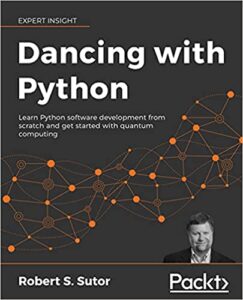
My new book Dancing with Python: Learn Python software development from scratch and get started with quantum computing is now available for purchase from Amazon and Packt Publishing.
Develop skills in Python by implementing exciting algorithms, including mathematical functions, classical searching, data analysis, plotting data, machine learning techniques, and quantum circuits.
Key Features
Learn Python basics to write elegant and efficient code
Create quantum circuits and algorithms using Qiskit and run them on quantum computing hardware and simulators
Delve into Python’s advanced features, including machine learning, analyzing data, and searching
Contributors
About the author
About the reviewer
Contents
List of Figures
Preface
Why did I write this book?
For whom did I write this book?
What does this book cover?
What conventions do I use in this book?
Get in touch
1 Doing the Things That Coders Do
1.1 Data
1.2 Expressions
1.3 Functions
1.4 Libraries
1.5 Collections
1.6 Conditional processing
1.7 Loops
1.8 Exceptions
1.9 Records
10 Contents
1.10 Objects and classes
1.11 Qubits
1.12 Circuits
1.13 Summary
I Getting to Know Python
2 Working with Expressions
2.1 Numbers
2.2 Strings
2.3 Lists
2.4 Variables and assignment
2.5 True and False
2.6 Arithmetic
2.7 String operations
2.8 List operations
2.9 Printing
2.10 Conditionals
2.11 Loops
2.12 Functions
2.13 Summary
3 Collecting Things Together
3.1 The big three
3.2 Lists
3.3 The joy of O(1)
3.4 Tuples
3.5 Comprehensions
3.6 What does “Pythonic” mean?
3.7 Nested comprehensions
3.8 Parallel traverse
3.9 Dictionaries
3.10 Sets
3.11 Summary
4 Stringing You Along
4.1 Single, double, and triple quotes
4.2 Testing for substrings
4.3 Accessing characters
4.4 Creating strings
4.5 Strings and iterations
4.6 Strings and slicing
4.7 String tests
4.8 Splitting and stripping
4.9 Summary
5 Computing and Calculating
5.1 Using Python modules
5.2 Integers
5.3 Floating-point numbers
5.4 Rational numbers
5.5 Complex numbers
5.6 Symbolic computation
5.7 Random numbers
5.8 Quantum randomness
5.9 Summary
6 Defining and Using Functions
6.1 The basic form
6.2 Parameters and arguments
6.3 Naming conventions
6.4 Return values
6.5 Keyword arguments
6.6 Default argument values
6.7 Formatting conventions
6.8 Nested functions
6.9 Variable scope
6.10 Functions are objects
6.11 Anonymous functions
6.12 Recursion
6.13 Summary
7 Organizing Objects into Classes
7.1 Objects
7.2 Classes, methods, and variables
7.3 Object representation
7.4 Magic methods
7.5 Attributes and properties
7.6 Naming conventions and encapsulation
7.7 Commenting Python code
7.8 Documenting Python code
7.9 Enumerations
7.10 More polynomial magic
7.11 Class variables
7.12 Class and static methods
7.13 Inheritance
7.14 Iterators
7.15 Generators
7.16 Objects in collections
7.17 Creating modules
7.18 Summary
8 Working with Files
8.1 Paths and the file system
8.2 Moving around the file system
8.3 Creating and removing directories
8.4 Lists of files and folders
8.5 Names and locations
8.6 Types of files
8.7 Reading and writing files
8.8 Saving and restoring data
8.9 Summary
II Algorithms and Circuits
9 Understanding Gates and Circuits
9.1 The software stack
9.2 Boolean operations and bit logic gates
9.3 Logic circuits
9.4 Simplifying bit expressions
9.5 Universality for bit gates
9.6 Quantum gates and operations
9.7 Quantum circuits
9.8 Universality for quantum gates
9.9 Summary
10 Optimizing and Testing Your Code
10.1 Testing your code
10.2 Timing how long your code takes to run
10.3 Optimizing your code
10.4 Looking for orphan code
10.5 Defining and using decorators
10.6 Summary
11 Searching for the Quantum Improvement
11.1 Classical searching
11.2 Quantum searching via Grover
11.3 Oracles
11.4 Inversion about the mean
11.5 Amplitude amplification
11.6 Searching over two qubits
11.7 Summary
III Advanced Features and Libraries
12 Searching and Changing Text
12.1 Core string search and replace methods
12.2 Regular expressions
12.3 Introduction to Natural Language Processing
12.4 Summary
13 Creating Plots and Charts
13.1 Function plots
13.2 Bar charts
13.3 Histograms
13.4 Pie charts
13.5 Scatter plots
13.6 Moving to three dimensions
13.7 Summary
14 Analyzing Data
14.1 Statistics
14.2 Cats and commas
14.3 pandas DataFrames
14.4 Data cleaning
14.5 Statistics with pandas
14.6 Converting categorical data
14.7 Cats by gender in each locality
14.8 Are all tortoiseshell cats female?
14.9 Cats in trees and circles
14.10 Summary
15 Learning, Briefly
15.1 What is machine learning?
15.2 Cats again
15.3 Feature scaling
15.4 Feature selection and reduction
15.5 Clustering
15.6 Classification
15.7 Linear regression
15.8 Concepts of neural networks
15.9 Quantum machine learning
15.10 Summary
Appendices
A Tools
A.1 The operating system command line
A.2 Installing Python
A.3 Installing Python modules and packages
A.4 Installing a virtual environment
A.5 Installing the Python packages used in this book
A.6 The Python interpreter
A.7 IDLE
A.8 Visual Studio Code
A.9 Jupyter notebooks
A.10 Installing and setting up Qiskit
A.11 The IBM Quantum Composer and Lab
A.12 Linting
B Staying Current
B.1 python.org
B.2 qiskit.org
B.3 Python expert sites
B.4 Asking questions and getting answers
C The Complete UniPoly Class
D The Complete Guitar Class Hierarchy
E Notices
E.1 Photos, images, and diagrams
E.2 Data
E.3 Trademarks
E.4 Python 3 license
F Production Notes
References
Other Books You May Enjoy
Index
Index Formatting Examples
Python function, method, and property index
Python class index
Python module and package index
General index
Share this:
Dancing with Qubits: Quantum Computing and Finance update
In section 1.5 of my quantum computing book Dancing with Qubits, I discuss potential applications of the technology to financial services. An excellent survey article by my IBM Quantum colleagues is now on arXiv that updates and goes into much greater detail than what I covered.
“Quantum computing for Finance: state of the art and future prospects” by Daniel J. Egger, Claudio Gambella, Jakub Marecek, Scott McFaddin, Martin Mevissen, Rudy Raymond, Andrea Simonetto, Stefan Woerner, and Elena Yndurain has this abstract:
This paper outlines our point of view regarding the applicability, state of the art, and potential of quantum computing for problems in finance. We provide an introduction to quantum computing as well as a survey on problem classes in finance that are computationally challenging classically and for which quantum computing algorithms are promising. In the main part, we describe in detail quantum algorithms for specific applications arising in financial services, such as those involving simulation, optimization, and machine learning problems. In addition, we include demonstrations of quantum algorithms on IBM Quantum back-ends and discuss the potential benefits of quantum algorithms for problems in financial services. We conclude with a summary of technical challenges and future prospects.
I highly recommend it.
Share this:
IEEE Quantum Week and IBM Quantum

This year’s IEEE Quantum Week is planned for October 12-16, 2020, in Denver, Colorado.
IEEE Quantum Week is a multidisciplinary quantum computing venue where attendees will have the unique opportunity to discuss challenges and opportunities with quantum researchers, scientists, engineers, entrepreneurs, developers, students, practitioners, educators, programmers, and newcomers.
 The IBM Quantum team is well represented at the conference with a keynote from Jerry Chow. We also have 7 tutorials and 2 workshops.
The IBM Quantum team is well represented at the conference with a keynote from Jerry Chow. We also have 7 tutorials and 2 workshops.
Our tutorials are on the following topics:
- Quantum programming, an introduction
- Quantum machine learning for data scientists
- Quantum hardware control: a hands-on introduction
- Quantum algorithms for optimization
- Quantum algorithms for chemistry simulation
- Assessing the quality of qubits and quantum computers
- Serious Games for Quantum Computing
Our workshops are:
- Control and design of superconducting qubits
- Software for quantum applications, algorithms, and workflows
Registration is now open.
Share this:
Tonya Hall and I talk about quantum computing and Dancing with Qubits
It was my pleasure to talk again with Tonya Hall of ZDNet about quantum computing and, in particular, my book Dancing with Qubits. You can watch the video on YouTube:
Share this:
Ethan Hansen and I talk about quantum computing in this new podcast
Please join Ethan Hansen and me on Spotify as we talk about quantum computing and my book Dancing with Qubits.
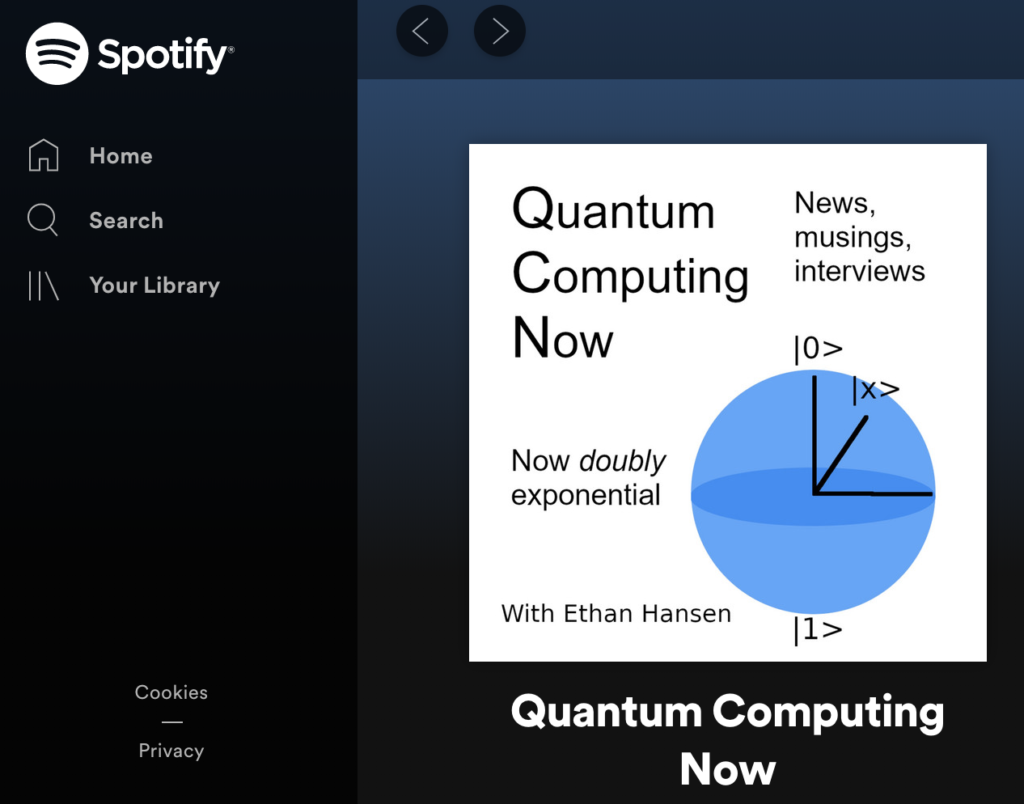
Share this:
How to listen to my Packt podcast about quantum computing on your phone
The Packt podcast with me talking about my quantum computing and my book Dancing with Qubits is now available. Here is how you can listen to it on your iPhone. I presume the directions for Android are similar.
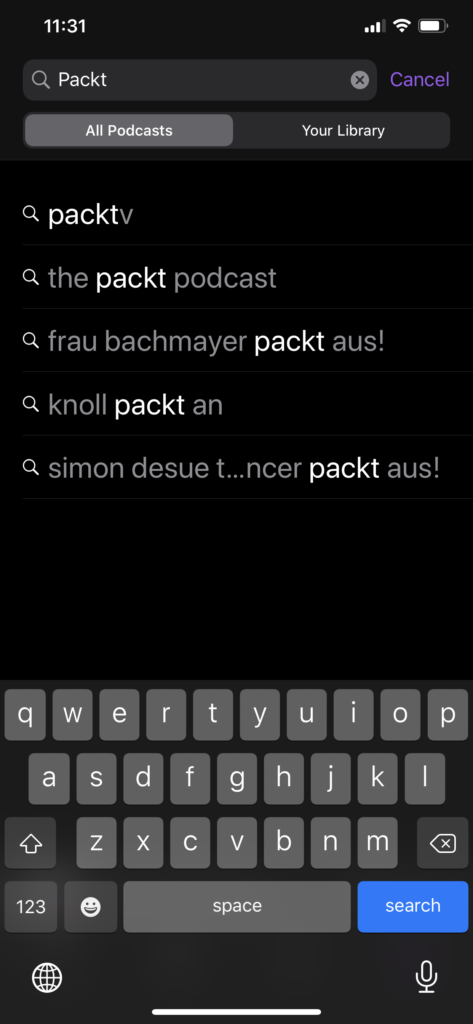 Open the Podcasts app on your phone. Click the magnifying glass and type
Open the Podcasts app on your phone. Click the magnifying glass and type Packt into the search field. Press Search. Press the packt podcast in the search results.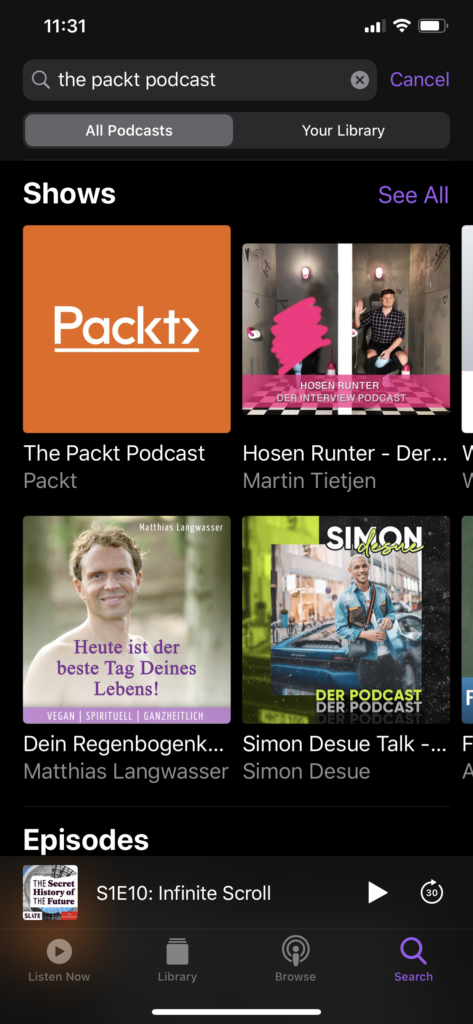 Press The Packt Podcast under the listing of Shows. The logo is white text that says Packt on an orange background.
Press The Packt Podcast under the listing of Shows. The logo is white text that says Packt on an orange background.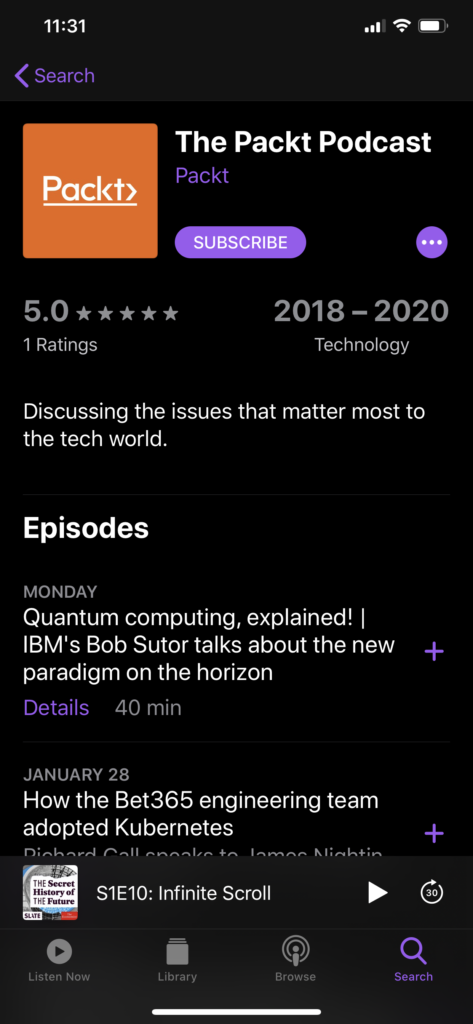 Under Episodes, look for Quantum computing, explained!. You may need to scroll down. It appeared on February 10, 2020.
Under Episodes, look for Quantum computing, explained!. You may need to scroll down. It appeared on February 10, 2020.Share this:
SoundCloud Packt podcast with me about Dancing with Qubits and #QuantumComputing
Please join Stacy Munro, Richard Gall, and me for a podcast discussion about my new book about quantum computing, Dancing with Qubits.
https://soundcloud.com/packt-podcasts/quantum-computing-explained-ibms-robert-sutor-talks-about-the-new-paradigm-on-the-horizon
Share this:
The Amazon Kindle version of Dancing with Qubits is now available!
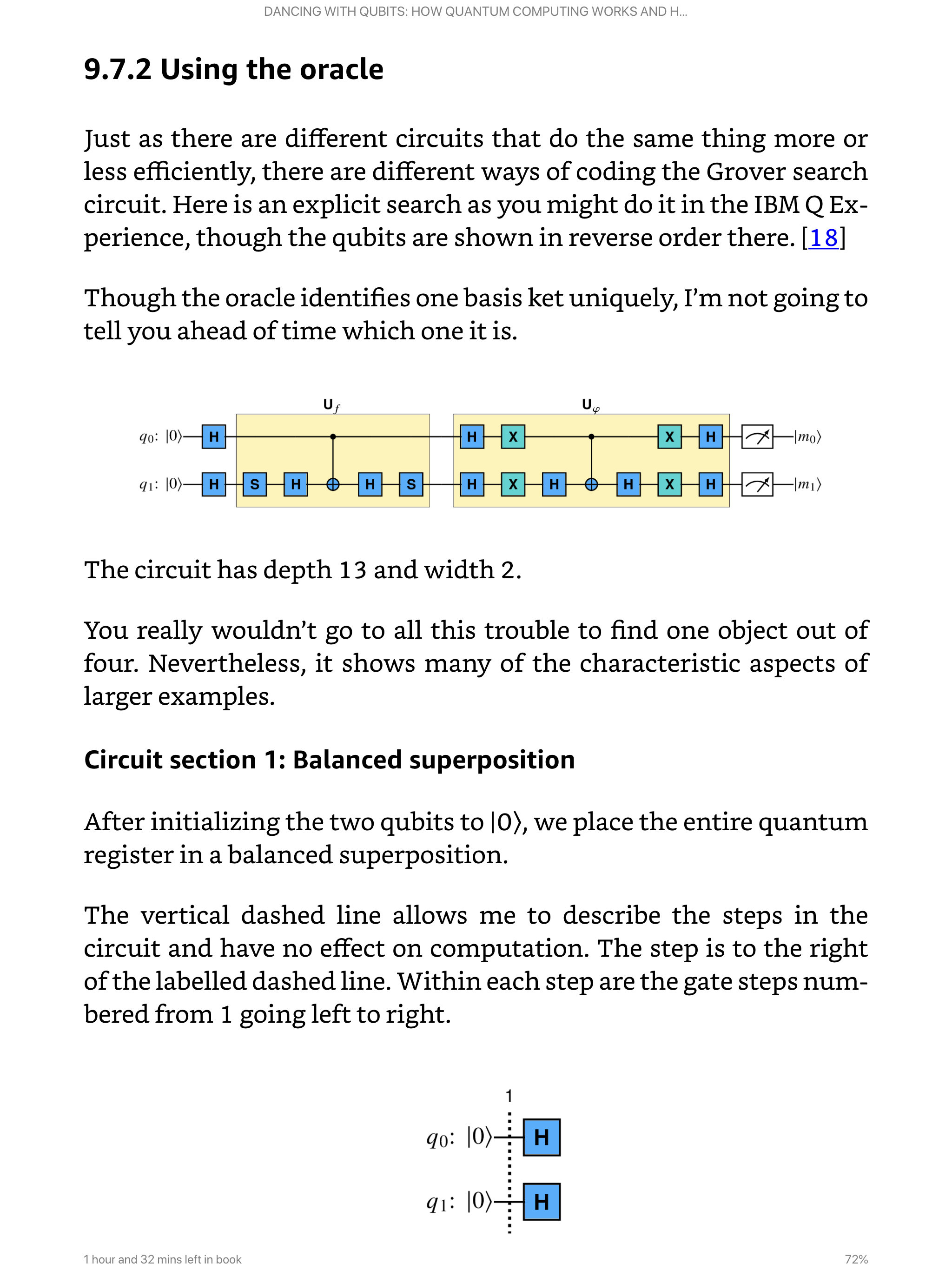 I’m pleased to announce that the Amazon Kindle version of my quantum computing book Dancing with Qubits is now available!
I’m pleased to announce that the Amazon Kindle version of my quantum computing book Dancing with Qubits is now available!
This book provides a comfortable and conversational introduction to quantum computing. I take you through the mathematics you need at a pace that allows you to understand not just “what” but also “why.” When we get to quantum computing, concepts like superposition and entanglement are shown to be natural ideas building on what we’ve already seen, and then illustrated via gates, circuits, and algorithms.
Throughout the book, I highlight important results, provide questions to answer, and give links to references where you can learn more. This allows the book to be used for self-study or as a textbook.
Important ideas like Quantum Volume are explained to give you a head start for reading more advanced texts and research papers. I provide many references to related content in math, physics, quantum computing, AI, and financial services. Dancing with Qubits concludes with questions for you to think about and ask experts so that you can gauge progress in the field over the next few years.
Features of the Kindle edition
- The text will get larger or smaller as you wish and you can change to a font that is comfortable for you to read.
- There are links throughout the book to other sections and the references in each chapter.
- Many of the references have links to external sources, such as arxiv or Nature for research papers.
- The content is in color, if your Kindle device supports it.
- You can search for terms throughout the book.
- I’ve maximized the number of mathematical expressions that are expressed textually (see below) to improve the reading experience.
The print version of Dancing with Qubits still has the full, rich mathematical formatting, albeit in black and white. In essence, whether you choose the print or Kindle version, the content is consistent and the formatting is the best I know how to produce for each medium.
Technical Notes
Here are a few comments about the production of the Kindle version, in case you are interested.
- The original content for Dancing with Qubits is in LaTeX. From that I can produce the black and white print version, a color PDF eBook, and an epub3 file from which the Amazon Kindle and several other MOBI eBook versions are created.
- I used make4ht and tex4ht to go from the LaTeX source files to HTML. While very powerful, the documentation is scarce and I spent many hours trying to figure how to make things work and then writing sed and Python scripts to fix things that were not quite right.
- I wrote Python scripts to create the various files needed for epub3, such as opf and navigation, and to break the 30,000+ line HTML file into smaller XHTML files. I used tidy several times to format the HTML and XHTML.
- The epub3 validators in several free epub3 editing apps either skipped problems entirely or gave false negatives. I found pagina EPUB-Checker to be the best software for validation.
- I wanted to maximize the amount of HTML formatting I could use and MathML is not available in a practical sense for all eBook formats. tex4ht produced very inconsistent results. So while I could express $x_2$ as x2 in the text without extra fonts, more two-dimensional objects like matrices had to be represented using images. I created macros to produce the right format based on what kind of document I was trying to produce.
- I used tikz/pgf and quantikz for the figures, especially the quantum circuit diagrams. I externalized the figures as JPEG images. It took quite a bit to figure out how to get them to be the right size for the Kindle version.
- Some math expressions in the book and chapter tables of contents have weird spacing if they involve subscripts or superscripts. This is an artifact of the Kindle software. This did not happen, for example, when I viewed the book in the Apple Books app.
Share this:
Some practical things you can do to learn about quantum computing
People often ask me “Where should I get started in order to learn about quantum computing?”. Here are several steps you can take. I work for IBM, so things I link to will often be to the IBM Quantum program. Also, I acknowledge that several of the links and videos toward the beginning involve me, but we’ll get through those quickly.
Watch some introductory videos
If you only watch one video, watch this one from WIRED with Talia Gershon:
This one with me is from early 2019 and discussed the IBM Q System One:
Finally, this video from CNBC with Professor Scott Aaronson of the University of Texas Austin, Martin Reynolds of Gartner, and me brings things up to date in January, 2020. Note that I personally do not support many of the statements about “Quantum Supremacy” (horrible label, supercomputers do have massive amounts of storage, off-by-15-million-percent math error):
Get a book
If you are really just getting started and want to systematically work through the required math at an easy and conversational pace, my book Dancing with Qubits should prepare you for more advanced material and give you a start to reading research papers. (Shameless self-plug.)
If you are a hard core physics and/or computer science person, you want to have Quantum Computation and Quantum Information: 10th Anniversary Edition 10th Anniversary ed. Edition by Michael A. Nielsen and Issac L. Chuang in your library. It’s a little old by now, but if you want to end up doing quantum computing research, you will likely have to become very familiar and comfortable with the contents. Other books to consider are Quantum Computing: A Gentle Introduction (good on algorithms, “gentle” is subjective!) and Quantum Computing for Computer Scientists (a bit dated and make sure you get a copy of the errata).
Play a game
Hello Quantum is available for Apple iOS and Android and will teach you the basics of how quantum gates and circuits work.
Build and run circuits with a real quantum computer
Quantum simulators have their place for basic education, experimentation, and debugging. Note, though, that a quantum simulator is to real quantum computer hardware as a TV console flight simulator is to a real plane. If you want a job as a pilot, I would prefer you knew how to fly an actual airplane.
The easiest way to get started without writing code is with the IBM Quantum Composer within the IBM Quantum Experience.
The IBM Quantum Experience has over 200,000 registered users, so you’ll be joining a very large community of beginner, intermediate, and advanced users.
Learn Python
If you are going to write quantum computing code, learn Python. As I write this, the latest version is 3.8. You want Python 3, not Python 2.
Learn Jupyter Notebooks
This is the modern way of developing full documents with interactive code, executions, graphics, videos, and visualizations. It’s used within the IBM Quantum Experience but also many other computational and AI applications. You are mainly interested in how to use it through a browser, not how to run and maintain the console.
Website (introductory): Introduction to Jupyter Notebooks
Write quantum computing code in Qiskit
Qiskit is the leading open source platform for developing quantum computing code and applications. It’s available on Github and available under the Apache 2,0 license. It’s had over 300,000 downloads but I’m recommending you use it through your browser on the IBM Cloud. As with the Composer, it is available through the IBM Quantum Experience.
Whether you want to download Qiskit or use it online, the easiest way to get get started is to watch the series of videos by Abe Asfaw.
From there, you can watch the other videos and also learn about the Qiskit Community.
At this point you are ready to work your way through the online open source Learn Quantum Computing through Qiskit.
Share this:
My YouTube quantum computing playlist
I have a running YouTube playlist about quantum computing where I capture videos mostly about quantum computing in general, IBM Quantum, the Qiskit open source quantum computing development environment, and my book Dancing with Qubits.
Share this:
Podcast: Meet the meQuanics with Simon Devitt and me
My podcast with Simon Devitt discussing quantum computing, IBM Quantum, and my new book Dancing with Qubits is now available on Spotify.
Share this:
Dancing with Qubits is #1 on the BookAuthority list of the 13 Best New Quantum Computing Books To Read In 2020
I’m honored to have Dancing with Qubits topping this list from BookAuthority!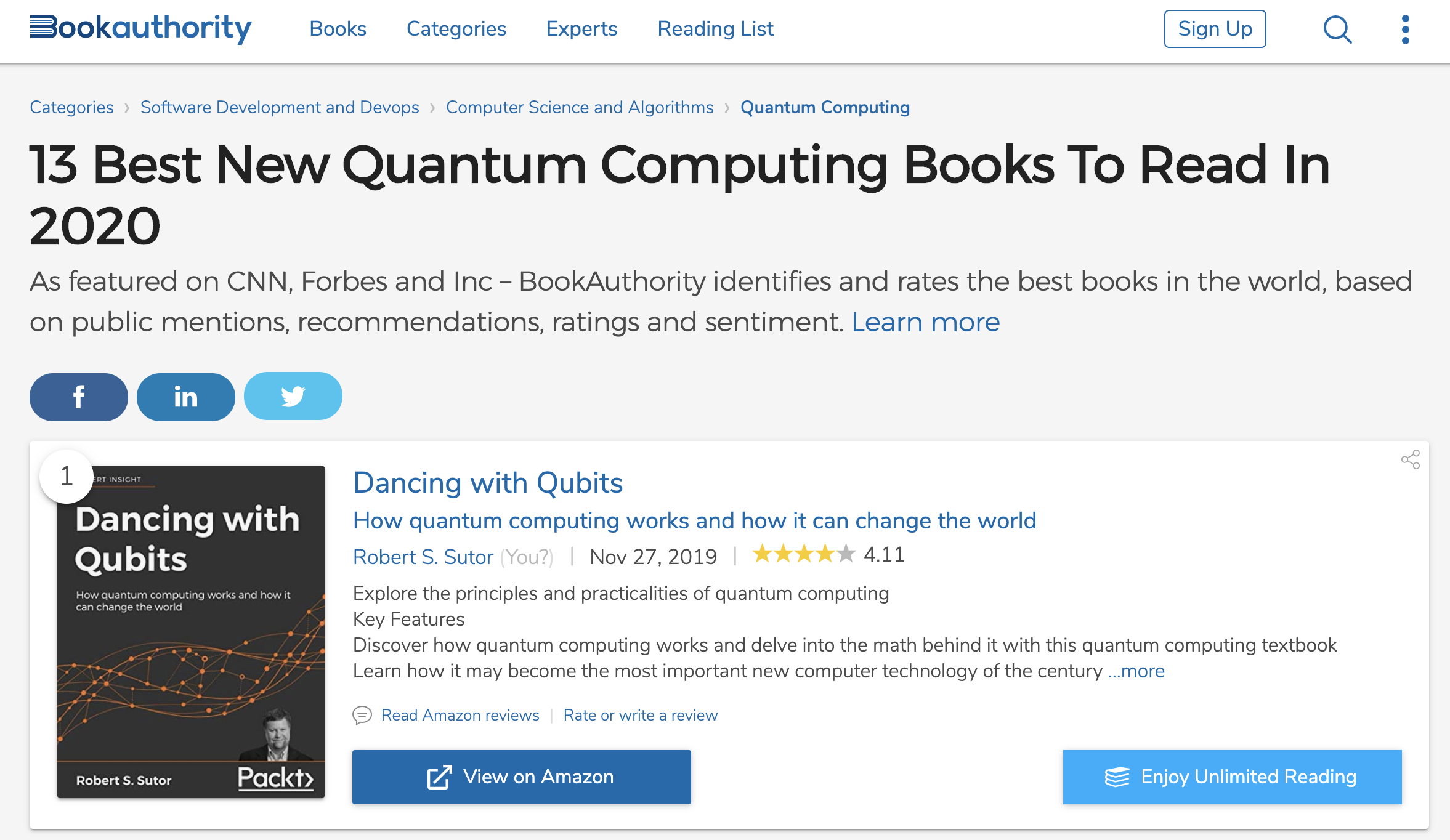
Share this:
Excerpt from Chapter 1 of Dancing with Qubits
Packt, the publisher of my quantum computing book Dancing with Qubits, just put this excerpt from the first chapter up on its website.
Share this:
Great review of Dancing with Qubits by The Quantum Daily
I really appreciate this review of my new book Dancing with Qubits about quantum computing by Matt Swayne at The Quantum Daily!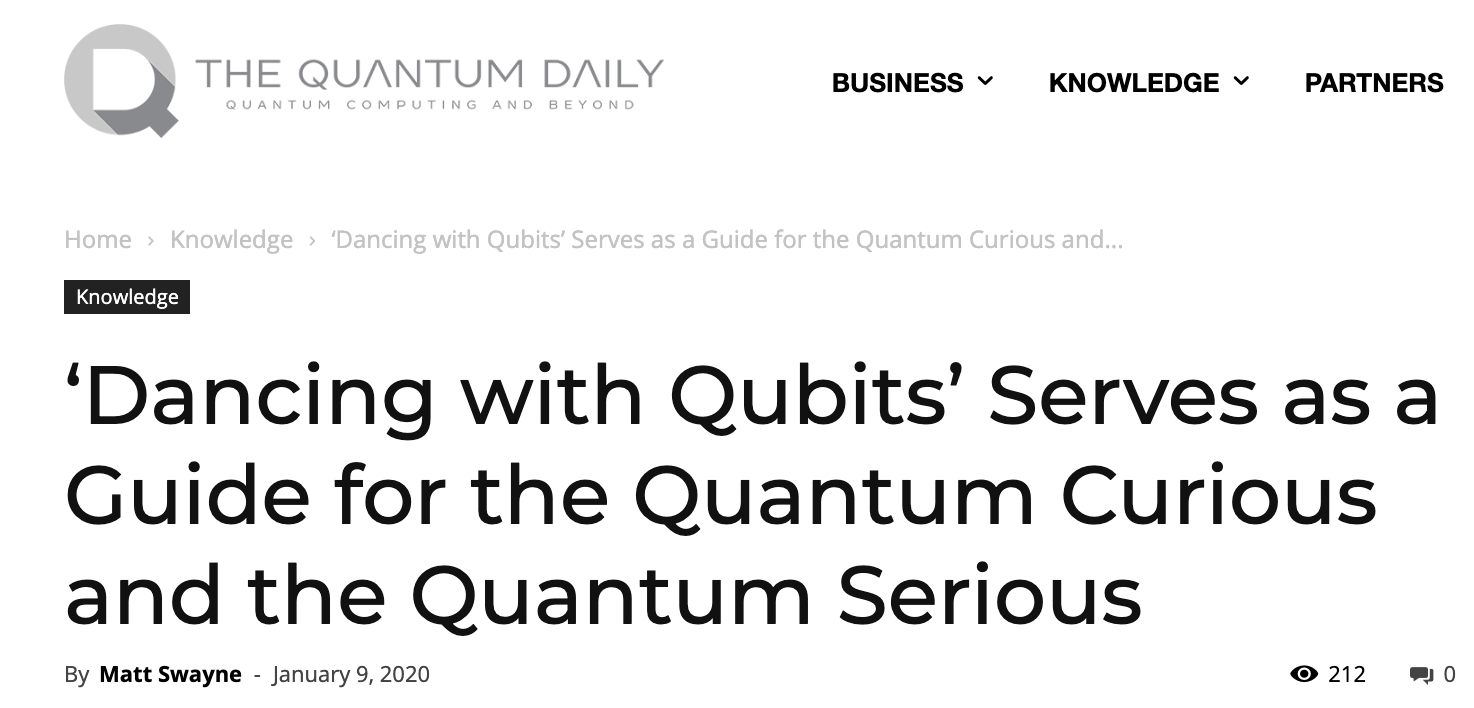
Share this:
January 7, 2020: I’m speaking at HICSS – The Hawaii International Conference on System Sciences
Next week I’ll be speaking at HICSS in Maui, Hawaii, about quantum computing. I’ll also be answering questions about and signing copies of my book Dancing with Qubits.
